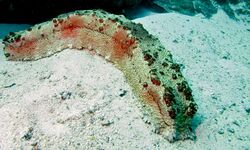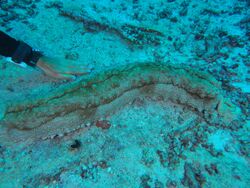Biology:Thelenota anax
| Thelenota anax | |
|---|---|

| |
| Scientific classification | |
| Domain: | Eukaryota |
| Kingdom: | Animalia |
| Phylum: | Echinodermata |
| Class: | Holothuroidea |
| Order: | Synallactida |
| Family: | Stichopodidae |
| Genus: | Thelenota |
| Species: | T. anax
|
| Binomial name | |
| Thelenota anax | |
Thelenota anax is a species of sea cucumber mostly found in the tropical, South Pacific Ocean. It is also commonly known as the amber fish.[3] Some other names for T. anax are black teatfish, blackfish, brownfish, chief sea cucumber, curryfish, elephant trunk cucumber, lollyfish, tripang, and white-teat sea cucumber.[4] T. anax is found on sandy ocean bottoms and often have ectocommensal relationships. They are commonly fished commercially and exported because of their medicinal properties and large size.
Description
The body of T. anax can be a creamy beige or light brown with dark brown or red spots. It usually has light colored bumps on the top of its body. T. anax also has large with papillae located laterally on its body. On its ventral surface there is long white podia. Its mouth is also located ventrally with 18-20 peltate tentacles. The anus is located on the dorsal side of the animal towards the terminal end. Their average length is about 69 cm long, but the longest recorded sea cucumber was 89 cm long.[5] Some of the biggest sea cucumber can weigh up to 5 kg.[6] It also has two gonads that are approximately 70-500mm long.[7]
Habitat
Thelenota anax prefers to live on soft, sandy portions of the ocean floor at depths greater than 25 m.[8] Some can be found on the sides of reef slopes.[5]
Ectocommensals
Some organism can often be found living on the outside of Thelenota anax. A few common species found on T.anax are scaleworms and gastropods.[9] The sea cucumber does not appear to be negatively affected by these ectocommensal species.
Commercial value
Many species of sea cucumbers are sold for human consumption as "beche-de-mer". In the Solomon Islands, where Thelenota anax is commonly harvested, it has a commercial value of around $6.66 per kg .[10] It is one of the less expensive species of sea cucumbers, but is one of the more commonly exported species because of its high body mass.[11]
Medicinal properties
T. anax is commonly consumed in Asian and Middle Eastern countries for its purported medicinal benefits, although research into its effects are ongoing. T. anax produces many different bioactive compounds such as arachidonic acid, eicosapentaenoic acid, and docosahexaenoic acid. These compounds are known to reduce the risk of coronary disease, some cancers, and have anti-inflammatory properties [3] Specifically arachidonic acid promotes blood clotting and wound healing.[12] This is why many Asian countries use T.anax to treat burns and cuts.[3]
Studies have also shown that T. anax produces glycosides Stichopside C (STC) and Stichoposide D (STD).[13] STC makes Ceramide, which is a tumor suppressor lipid. It also causes the apoptosis of colorectal cancer cells and leukemia cells. STD causes the apoptosis of only leukemia cells and inhibits its growth.[14]
References
- ↑ "WoRMS - World Register of Marine Species - Thelenota anax Clark, 1921". https://www.marinespecies.org/aphia.php?p=taxdetails&id=210915.
- ↑ Clark, H.L. (1921). The echinoderm fauna of Torres Strait: its composition and its origin. Department of Marine Biology of the Carnegie Institute. https://www.biodiversitylibrary.org/page/14516106.
- ↑ 3.0 3.1 3.2 "High-value components and bioactives from sea cucumbers for functional foods--a review". Marine Drugs 9 (10): 1761–805. 2011-10-10. doi:10.3390/md9101761. PMID 22072996.
- ↑ "The Royal Sea Cucumber - Whats That Fish!". https://www.whatsthatfish.com/fish/royal-sea-cucumber/309.
- ↑ 5.0 5.1 Commercially Important Sea Cucumbers of the World. FAO Species Catalogue for Fishery Purposes No. 6. Rome: Food and Agriculture Organization of the United Nations. 2012. ISBN 978-92-5-106719-2. http://www.fao.org/3/i1918e/i1918e00.htm.
- ↑ Survey of the shallow-water sea cucumbers of the central Philippines. (Report). University Of Guam Marine Laboratory. 30 June 2006. https://www.researchgate.net/publication/268346778. "A Report to the Municipalities of Negros Oriental, Cebu and Bohol, local Bantay Dagat groups, Coastal Conservation and Education Foundation, Inc., and Silliman University-Angelo King Center for Research and Environmental Management."
- ↑ Lamberson, Janet O. (June 1978). "Marshall Islands 96737". Mid-Pacific Marine Laboratory Enewetak 14.
- ↑ "The Distribution of Sea Cucumbers in Pulau Aur, Johore, Malaysia". Publications of the Seto Marine Biological Laboratory 8: 73–86. 2007. doi:10.5134/70908. ISSN 0389-6609. https://repository.kulib.kyoto-u.ac.jp/dspace/handle/2433/70908.
- ↑ "Ectocommensals of the stichopodid sea cucumbers Thelenota anaxand Stichopus vastuson the northern Great Barrier Reef". SPC Beche-de-mer Information Bulletin 40. March 2020. https://www.spc.int/DigitalLibrary/Doc/FAME/InfoBull/BDM/40/BDM40_20_Purcell.pdf.
- ↑ "Effect of diel activity patterns and harvesting pressure on the diversity and biomass of sea cucumbers in Marovo Lagoon, Solomon Islands". Environmental Management 45 (5): 963–73. May 2010. doi:10.1007/s00267-010-9469-3. PMID 20349313. Bibcode: 2010EnMan..45..963B.
- ↑ "Value, market preferences and trade of Beche-de-mer from Pacific Island sea cucumbers". PLOS ONE 9 (4): e95075. 2014. doi:10.1371/journal.pone.0095075. PMID 24736374. Bibcode: 2014PLoSO...995075P.
- ↑ "Use of species-specific PCR for the identification of 10 sea cucumber species.". Chinese Journal of Oceanology and Limnology 32 (6): 1257–63. November 2014. doi:10.1007/s00343-015-4050-9. Bibcode: 2014ChJOL..32.1257W.
- ↑ "Sea Cucumber Glycosides: Chemical Structures, Producing Species and Important Biological Properties". Marine Drugs 15 (10): 317. October 2017. doi:10.3390/md15100317. PMID 29039760.
- ↑ "Ceramide as a Target of Marine Triterpene Glycosides for Treatment of Human Myeloid Leukemia". Marine Drugs 14 (11): 205. November 2016. doi:10.3390/md14110205. PMID 27827870.
Wikidata ☰ Q301271 entry
 |



